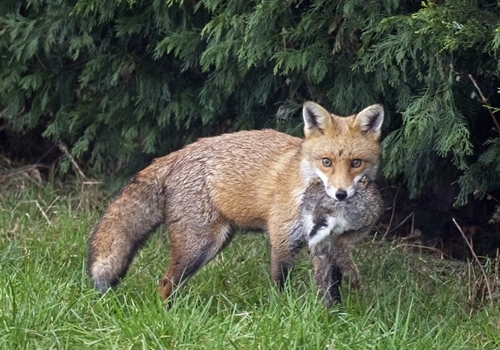
4 minute read
By Jenny Coomes and Dr. Jen Brewin
This spring, GWCT researchers will be starting a new research project looking into one of the most contentious issues around the release of gamebirds in the UK: the idea that gamebird releasing may support foxes and other generalist predators into an area.
Despite being a topical subject, which generates much interest and speculation, currently there is no firm evidence to show whether gamebird releases either do or do not lead to local increases in fox population size. If they do, these predators might have a greater negative impact on local wildlife populations, so it is very important to address the question with robust science.
To examine the issue, researchers from GWCT are setting out to collect data over the next 18 months looking at the number of foxes present at several sites in central southern England that release gamebirds (pheasants and/or red-legged partridges), and a similar number of sites that do not. Comparing these sites will allow us to address the question “Do released sites support more foxes than non-release sites?”
Foxes are very difficult to monitor and the best method to assess numbers for this kind of research is to walk a fixed distance route (called a transect) at our chosen sites and be on the look out to collect fox droppings, called scats. The transects will be around 3km long and we will be walking at 16 sites, twice a month for a whole year. This means we will be walking 1152km or 715 miles – the equivalent of 27 and a half marathons!
Whilst walking the transects, we will also count the number of released gamebirds we see, so we can be sure that non-releasing sites really do have relatively few gamebirds, and the releasing sites really do have more. This is an important aspect of the scientific design – ensuring that we collect data which is robust, reliable and accurate.
After we have collected the fox scats, there are a number of things we will do with them. First we will use the number of scats per site to estimate the number of foxes and will compare this with our gamebird data. Second, the scats will be sent to a lab to be ‘genotyped’. This technique analyses DNA in the scat and because, like all living things, the genetic code of every fox is unique, it allows us to identify the individual fox that produced each scat.
We can then make a better estimate of the total number of foxes at each site which is important for answering our question. Third, we are also interested in finding out how much of the fox diet is made up of gamebirds so we will be examining our collected scats closely for evidence, and can do this in two ways. The slightly more messy method is to break the scats apart, wash them to remove soil and non-food items, before looking under a microscope to detect parts of pheasant and red-legged partridge feathers.
Looking through fox poo may not be the most glamorous job (!) but it is a vital part of our understanding of how released gamebirds impact fox populations.
The second way to examine fox diet uses DNA to identify all the prey items (not just gamebirds) in the scat. Small sequences of DNA called ‘primers’ are added to the scat sample which then attach to the prey DNA. The primers act as markers so that when the DNA sample is scanned, the prey sequences show up and we can identify the prey eaten by the fox.
It’s a bit like scanning the barcode in a supermarket, each item has its own unique barcode which is identified by the scanner and tells you what the item is. DNA analysis is a relatively new technique and has many different uses such as finding out what animal species are present in our rivers, identifying predators of crop pests and discovering which insects are likely to pass on diseases.
There are a number of other methods in our toolkit to help us find out how many foxes are at our sites, including trail cameras set up along our transect routes and handheld thermal imaging cameras for scanning across a landscape and counting foxes at night.
Trail cameras are a common method to record elusive animals, you can even set one up in your garden to capture any usually unseen visitors, but thermal imaging technology hasn’t yet been used in research to estimate numbers of nocturnal animals. We are still developing exactly how we might use these techniques to support the project, but they have potential in studying a species which is otherwise very difficult to observe in the wild.
Assessing whether the location or number of foxes in the landscape changes with the number of gamebirds released in an area, or whether their diet changes, will help us understand whether these predators might be having an increased impact on other species such as ground nesting birds, particularly those that are of conservation concern.
Carrying out robust scientific research to address fundamental issues such as this, as well as communicating and applying those findings to help develop effective and positive countryside management, is one of the core objectives here at the GWCT. The results of this study are expected towards the end of 2023, and we hope they will be worth the wait.
BASC made a significant donation to the GWCT which enabled this research study to go ahead.